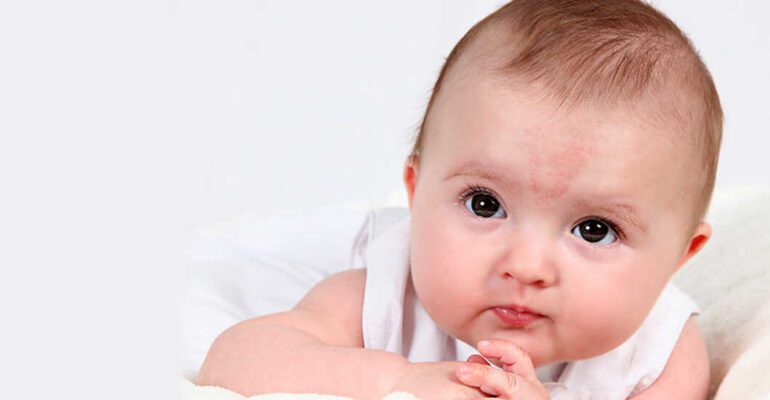Birthmarks- handling the psychological impact
April 7, 2020 2020-04-07 6:07Birthmarks- handling the psychological impact
As an Amazon associate, Dermatocare earns from valid purchase made by clicking on the affiliate links in this blog.

Birthmarks- handling the psychological impact
“Doctor, Can a birthmark be of white colour? Will it grow bigger? Is it treatable? Won’t our child feel bad when he grows up?” These are the questions I am confronted with when people see a light-colored birthmark on the forehead of my child.
The word “Birthmark” usually creates a picture of a black coloured spots/bumps in our mind; however there are hundreds of types of birthmarks with a varied presentation. Also, the psychological impact of birthmark can be devastating as even a single comment, or an awkward gaze can hurt the self-esteem of your kid. The purpose of this article is not to help you in diagnosing which type of birthmark your child has, instead to make you aware of the most common birthmarks and what you should do if your kid has one.
What are birthmarks?
Birthmarks are areas of discoloration with or without alteration in the texture of skin that arise due to an error in the organising of the cells of the skin, blood vessels, muscles, etc. during the time of development. These are usually present at birth but may present themselves later in early years of life.
What causes birthmark?
The cause of birthmarks is not known precisely. They are neither inherited from the parents nor is there any proven causative factor which could trigger birthmark formation in your kid. So, do not feel guilty that any of your actions during pregnancy is the cause of the birthmark in your child.
What are the different kinds of birthmarks?
The various birthmarks are categorised on the basis of the type of cell they originate from; the most common ones are either derived from blood vessels or pigment forming cells.
- Birthmarks derived from pigment forming cells-
- Congenital Melanocytic nevi: The birthmarks with excess pigment forming cells in the superficial layer of skin present themselves as black coloured flat or raised birthmarks termed as Congenital Melanocytic nevi. They are quite common and can develop at birth or may develop in childhood. They are usually too small to warrant any treatment. Rarely, these moles can be big enough to cover more than half of the body. These are usually persistent and grow proportionate to body size.
- Mongolian spots: The birthmarks with excess pigment forming cells in the deeper layer of the skin appear as blue or purple coloured flat birthmarks known as Mongolian spots. They are very common, seen in 80% of dark-skinned babies, usually in Indians and Mongolians. They are generally present at birth and occur most commonly on the lower back. Mongolian spots usually fade with time, mostly before ten years of age; however in few cases, they might stay for a lifetime.
- Nevus of Otta: When similar blue coloured birthmarks are present on the face around the eye, then they are called Nevus of Otta.
- Café-au-laitt macules: Defective pigment forming cells in the superficial layer of skin can lead to light brown coloured birthmarks called as café-au-laitt macules. These are usually round or oval blended coffee-colored patches on the skin which are persistent and asymptomatic. One need not worry as long as they are few and small in size. However, if these spots are large and are more than six in number, they can be associated with other developmental abnormalities.
- Nevus Depigmentosus: Absence of pigment-forming cells in the superficial layer of skin leads to a white coloured flat patch called as Nevus Depigmentosus. They also stay all through your life. Sometimes, the hair over these white patches is also light coloured giving a striking contrast, especially in the Indian skin. But the good news is that they do not spread to other sites and are not associated with any complication.
- Birthmarks derived from blood vessels-
- Portwine stain or Stroke bite: Red coloured flat or raised birthmarks are usually a Portwine stain or Stroke bite made up of dilated blood vessels. These are commonly found on the head and neck area and appear as a flat pink area at the time of birth that gradually deepens in colour and become raised. Few of them disappear by the age of two years, but most of them stay and become quite disfiguring.
- Hemangioma: Red-colored raised and globular masses are usually Hemangioma filled with bunches of proliferating blood vessels. Hemangiomas appear similar to Portwine strain at birth, but they grow very fast and turn into globular masses in a year or two. The Hemangioma near eyes, nose or ears can disturb vision, breathing, and hearing respectively. However, they usually start regressing by five years of age and eventually disappear.
Besides these most common birthmarks, there are hundreds of rare forms, description of which is beyond the scope of this article.
Do all the birthmarks appear at birth?
No, your child can develop these birthmarks all throughout their childhood but more so during the first five years of life. There is also the possibility that the birthmark is so small that it remains unnoticed until later years when it grows bigger.
Are birthmarks associated with internal problems in the body?
Most of the birthmarks are restricted to the skin. However, they can rarely be associated with internal problems, especially in brain and eyes. So, it is always advisable to take your kid to a Dermatologist as soon as you notice a birthmark.
When should I consult a Dermatologist?
All the birthmarks except small moles should be shown to a doctor for the diagnosis of the type of birthmark, to rule out any associated internal anomaly and also to understand the schedule of follow-up if needed. You should also report to your doctor if the birthmark changes in size/colour/shape, grows bigger, bleeds, ulcerate, pains, itches, burns, etc.
Are birthmarks treatable?
Though the science has advanced by leaps and bounds, large and disfiguring birthmarks cannot be removed without leaving a scar even with the best of LASERS and surgery. The small birthmarks can be faded with LASERS especially the vascular ones. Kindly note, if the birthmark is treatable, it is critical to get the procedure done before your child starts going to school so that his/her self-esteem is not hurt.
How do I handle psychological impact of birthmarks?
The most wonderful part is that your kid does not know he/she has something unpleasant on his/her face until you make him/her realise so, or when he/she is old enough to have friends who can make fun of him/her. It is important to treat your child as if there is nothing unusual, without over pampering or showing dislike for the birthmark. Also, tell other people around you to do the same. If your child gets inquisitive about the birthmark, you can show some mole of yours and tell that his/ her mole is much bigger than yours.
Once your kid is big enough to understand, discuss with him/her about the birthmark openly and also keep on inquiring about how does he/she feels about having a birthmark especially if people stare at him/her or make a remark. If your kid is irritated or refuses to interact with other kids, then he might need special support to cope up with his/her peer group.
ROUTINE FINDER
Get free dermatologist-recommended regime by choosing your skin or concerns.

FACE

HAIRS

CHILD

BODY
